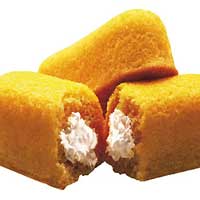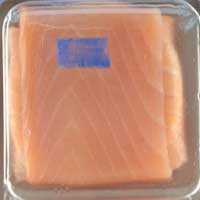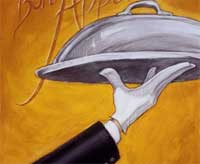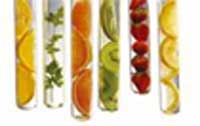Showing Spotlights 17 - 22 of 22 in category All (newest first):
 The food industry is excited about the potential of nanotechnology. Food companies are very much involved in exploring and implementing nanotechnology applications in food processing, packaging and even growing - but you don't hear about it anymore. At least not from the companies. Large industrial food companies, no stranger to big and expensive media campaigns, have buried the subject of nanotechnology in their public relations graveyard. Take Kraft Foods for example. While it took the industry's nanotechnology lead when it established the Nanotek Consortium in 2000, it has since pulled back completely on the PR front. The Nanotek Consortium even was renamed the 'Interdisciplinary Network of Emerging Science and Technologies' (INEST), is now sponsored by Altria, and its single webpage makes no mention of food at all. Doing our regular check on the websites of large food companies we again found not a single reference to 'nanotechnology' or even 'nano'. The same is true for large food industry associations such as the Grocery Manufacturers/Food Products Association (GMA/FPA), which represents the world's leading food, beverage and consumer products companies. Faced with a complete nanotechnology communications blackout from the manufacturers, it is left to activist groups like Friends of the Earth to frame the discussion. These groups are trying to figure out what the food industry is up to and if there might be any risks involved that we should know about.
The food industry is excited about the potential of nanotechnology. Food companies are very much involved in exploring and implementing nanotechnology applications in food processing, packaging and even growing - but you don't hear about it anymore. At least not from the companies. Large industrial food companies, no stranger to big and expensive media campaigns, have buried the subject of nanotechnology in their public relations graveyard. Take Kraft Foods for example. While it took the industry's nanotechnology lead when it established the Nanotek Consortium in 2000, it has since pulled back completely on the PR front. The Nanotek Consortium even was renamed the 'Interdisciplinary Network of Emerging Science and Technologies' (INEST), is now sponsored by Altria, and its single webpage makes no mention of food at all. Doing our regular check on the websites of large food companies we again found not a single reference to 'nanotechnology' or even 'nano'. The same is true for large food industry associations such as the Grocery Manufacturers/Food Products Association (GMA/FPA), which represents the world's leading food, beverage and consumer products companies. Faced with a complete nanotechnology communications blackout from the manufacturers, it is left to activist groups like Friends of the Earth to frame the discussion. These groups are trying to figure out what the food industry is up to and if there might be any risks involved that we should know about.
Apr 16th, 2008
 Most people when they hear the word semiconductor will think about their role in computers. However, semiconductors also absorb light, some absorb in the visible, thus appearing colored, e.g. gray silicon, and others in the UV, such as titanium dioxide, thus appearing white (when in microparticulate form) or colorless (when in nanoparticulate form). This light-absorbing feature is used to drive electrons around a circuit in photovoltaic cells, such as the silicon solar cell, but it can also be used to drive chemical reactions at the surface. A good example of the latter is the use of thin (15 nm) titanium dioxide film coatings on self-cleaning glass. These films upon absorbing UV light in sunlight are able to reduce oxygen, present in air, to water and oxidize any organic material on its surface to its minerals, thereby keeping the surface clean. Researchers in the UK have used this oxidation feature to developed an irreversible solvent-based blue ink, which upon activation with UV light, loses all its color and becomes oxygen sensitive; it will only gain its original color upon exposure to oxygen. A major application area for this oxygen ink is in food packaging where it could be used to detect a modified atmosphere inside food containers.
Most people when they hear the word semiconductor will think about their role in computers. However, semiconductors also absorb light, some absorb in the visible, thus appearing colored, e.g. gray silicon, and others in the UV, such as titanium dioxide, thus appearing white (when in microparticulate form) or colorless (when in nanoparticulate form). This light-absorbing feature is used to drive electrons around a circuit in photovoltaic cells, such as the silicon solar cell, but it can also be used to drive chemical reactions at the surface. A good example of the latter is the use of thin (15 nm) titanium dioxide film coatings on self-cleaning glass. These films upon absorbing UV light in sunlight are able to reduce oxygen, present in air, to water and oxidize any organic material on its surface to its minerals, thereby keeping the surface clean. Researchers in the UK have used this oxidation feature to developed an irreversible solvent-based blue ink, which upon activation with UV light, loses all its color and becomes oxygen sensitive; it will only gain its original color upon exposure to oxygen. A major application area for this oxygen ink is in food packaging where it could be used to detect a modified atmosphere inside food containers.
Jan 17th, 2008
 Having written in this space about the (possibly) good and the (possibly) bad of food nanotechnology before, here is now a scientific approach to assessing how the public perceives nanotechnology in food and food packaging. Swiss social psychologist Michael Siegrist has looked into the issues of trust, risk and the public acceptance of nanotechnology before. Now, he and his colleagues have taken the area of nanofoods and tried to understand what factors influence the willingness to buy food that has been produced, processed or packaged with nanotechnology. Their conclusion: Perceived benefits seems to be the most important predictor for willingness to buy.
Having written in this space about the (possibly) good and the (possibly) bad of food nanotechnology before, here is now a scientific approach to assessing how the public perceives nanotechnology in food and food packaging. Swiss social psychologist Michael Siegrist has looked into the issues of trust, risk and the public acceptance of nanotechnology before. Now, he and his colleagues have taken the area of nanofoods and tried to understand what factors influence the willingness to buy food that has been produced, processed or packaged with nanotechnology. Their conclusion: Perceived benefits seems to be the most important predictor for willingness to buy.
May 8th, 2007
 Nanotechnology has begun to find potential applications in the area of functional food by engineering biological molecules toward functions very different from those they have in nature, opening up a whole new area of research and development. Of course, there seems to be no limit to what food technologists are prepared to do to our food (read this delightful romp through the food processing industry to get the idea: "Twinkie, Deconstructed". For the non-U.S. reader: a Twinkie is a processed foodlike substance that has reached iconic status in this country) and nanotechnology will give them a whole new set of tools to go to new extremes. We have taken a critical view of food nanotechnology before in this column and in our news coverage, just take a look at "Nanotechnology food coming to a fridge near you" or "Are you ready for your nano-engineered wine?". Today, though, we look at the potentially beneficial effects nanotechnology-enabled innovations could have on our foods and, subsequently, on our health.
Nanotechnology has begun to find potential applications in the area of functional food by engineering biological molecules toward functions very different from those they have in nature, opening up a whole new area of research and development. Of course, there seems to be no limit to what food technologists are prepared to do to our food (read this delightful romp through the food processing industry to get the idea: "Twinkie, Deconstructed". For the non-U.S. reader: a Twinkie is a processed foodlike substance that has reached iconic status in this country) and nanotechnology will give them a whole new set of tools to go to new extremes. We have taken a critical view of food nanotechnology before in this column and in our news coverage, just take a look at "Nanotechnology food coming to a fridge near you" or "Are you ready for your nano-engineered wine?". Today, though, we look at the potentially beneficial effects nanotechnology-enabled innovations could have on our foods and, subsequently, on our health.
Apr 27th, 2007
 The potential benefits of Nanofoods - foods produced using nanotechnology - are astonishing. Advocates of the technology promise improved food processing, packaging and safety; enhanced flavor and nutrition; 'functional foods' where everyday foods carry medicines and supplements, and increased production and cost-effectiveness. In a world where thousands of people starve each day, increased production alone is enough to warrant worldwide support. For the past few years, the food industry has been investing millions of dollars in nanotechnology research and development. Some of the world's largest food manufacturers, including Nestle, Altria, H.J. Heinz and Unilever, are blazing the trail, while hundreds of smaller companies follow their lead. Yet, despite the potential benefits, compared with other nanotechnology arenas, nanofoods don't get a lot of publicity. The ongoing debate over nanofood safety and regulations has slowed the introduction of nanofood products, but research and development continue to thrive - though, interestingly, most of the larger companies are keeping their activities quiet (when you search for the term 'nano' or nanotechnology' on the websites of Kraft, Nestle, Heinz and Altria you get exactly zero results). Although the risks associated with nanotechnology in other areas, such as cosmetics and medicine, are equally blurry, it seems the difference is that the public is far less apt to jump on the nanotechnology bandwagon when it comes to their food supply.
The potential benefits of Nanofoods - foods produced using nanotechnology - are astonishing. Advocates of the technology promise improved food processing, packaging and safety; enhanced flavor and nutrition; 'functional foods' where everyday foods carry medicines and supplements, and increased production and cost-effectiveness. In a world where thousands of people starve each day, increased production alone is enough to warrant worldwide support. For the past few years, the food industry has been investing millions of dollars in nanotechnology research and development. Some of the world's largest food manufacturers, including Nestle, Altria, H.J. Heinz and Unilever, are blazing the trail, while hundreds of smaller companies follow their lead. Yet, despite the potential benefits, compared with other nanotechnology arenas, nanofoods don't get a lot of publicity. The ongoing debate over nanofood safety and regulations has slowed the introduction of nanofood products, but research and development continue to thrive - though, interestingly, most of the larger companies are keeping their activities quiet (when you search for the term 'nano' or nanotechnology' on the websites of Kraft, Nestle, Heinz and Altria you get exactly zero results). Although the risks associated with nanotechnology in other areas, such as cosmetics and medicine, are equally blurry, it seems the difference is that the public is far less apt to jump on the nanotechnology bandwagon when it comes to their food supply.
Dec 28th, 2006
 Researchers in the Netherlands investigated novel milk protein nanotubes with potentially interesting applications in the food and pharma industries.
Researchers in the Netherlands investigated novel milk protein nanotubes with potentially interesting applications in the food and pharma industries.
Mar 27th, 2006
 The food industry is excited about the potential of nanotechnology. Food companies are very much involved in exploring and implementing nanotechnology applications in food processing, packaging and even growing - but you don't hear about it anymore. At least not from the companies. Large industrial food companies, no stranger to big and expensive media campaigns, have buried the subject of nanotechnology in their public relations graveyard. Take Kraft Foods for example. While it took the industry's nanotechnology lead when it established the Nanotek Consortium in 2000, it has since pulled back completely on the PR front. The Nanotek Consortium even was renamed the 'Interdisciplinary Network of Emerging Science and Technologies' (INEST), is now sponsored by Altria, and its single webpage makes no mention of food at all. Doing our regular check on the websites of large food companies we again found not a single reference to 'nanotechnology' or even 'nano'. The same is true for large food industry associations such as the Grocery Manufacturers/Food Products Association (GMA/FPA), which represents the world's leading food, beverage and consumer products companies. Faced with a complete nanotechnology communications blackout from the manufacturers, it is left to activist groups like Friends of the Earth to frame the discussion. These groups are trying to figure out what the food industry is up to and if there might be any risks involved that we should know about.
The food industry is excited about the potential of nanotechnology. Food companies are very much involved in exploring and implementing nanotechnology applications in food processing, packaging and even growing - but you don't hear about it anymore. At least not from the companies. Large industrial food companies, no stranger to big and expensive media campaigns, have buried the subject of nanotechnology in their public relations graveyard. Take Kraft Foods for example. While it took the industry's nanotechnology lead when it established the Nanotek Consortium in 2000, it has since pulled back completely on the PR front. The Nanotek Consortium even was renamed the 'Interdisciplinary Network of Emerging Science and Technologies' (INEST), is now sponsored by Altria, and its single webpage makes no mention of food at all. Doing our regular check on the websites of large food companies we again found not a single reference to 'nanotechnology' or even 'nano'. The same is true for large food industry associations such as the Grocery Manufacturers/Food Products Association (GMA/FPA), which represents the world's leading food, beverage and consumer products companies. Faced with a complete nanotechnology communications blackout from the manufacturers, it is left to activist groups like Friends of the Earth to frame the discussion. These groups are trying to figure out what the food industry is up to and if there might be any risks involved that we should know about.
 Subscribe to our Nanotechnology Spotlight feed
Subscribe to our Nanotechnology Spotlight feed


